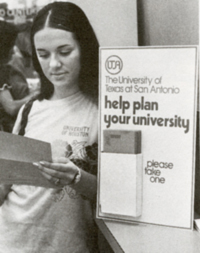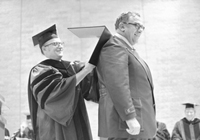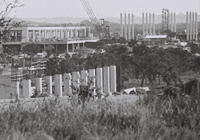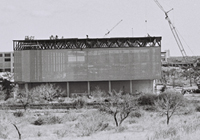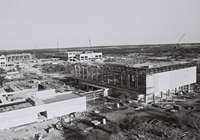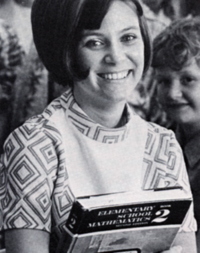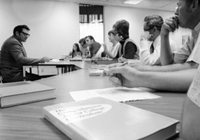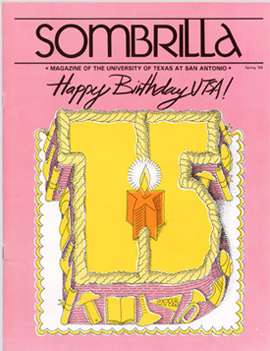Celebrating a Young Past
This article was first published in the spring 1988 issue of Sombrilla 1988. It celebrated UTSA's 15 years since the start of classes in 1973.
The date was June 5, 1973. American Graffiti was the delight of nostalgic movie-goers, and the affairs of an over aggressive political campaign in Washington, D.C.’s Watergate building covered the pages of daily newspapers.
In Texas, citizens were still mourning the winter loss of their president, Lyndon Baines Johnson. San Antonio was half its current size with a population of 654,153. [Editor's note: San Antonio's population in 1988 was 941,000] And a lanky, young Hispanic named Henry Cisneros was finishing his doctoral studies at MIT.
Across the nation on the college scene, only five public universities would begin classes that year for the first time, all of them in Texas. The University of Texas System opened branches in San Antonio, Odessa and Tyler. The University of Houston began offering classes in Victoria. And Corpus Christi State University also opened its doors to students for the first time. One of those would outdistance the others in many categories—enrollment, research, faculty pre-eminence and community involvement—but this day’s humble beginnings gave little indication.
With little fanfare UTSA began classes with summer school in 1973. Although established by the Legislature in 1969, it was four years later when UTSA’s first 671 students casually strolled into the books of history as they entered temporary classrooms in the Koger Executive Center.
The operating budget for that year was $5.5 million. Fifty-two faculty shared the benefit of their knowledge with students pursuing one of three degrees—a Master of Business Administration, Master of Arts or Master of Science.
Positioning itself not so much as an ivory tower for intellectuals, but as a training ground and consulting cadre for a multicultural community, UTSA’s first enrollments were weighted heavily in the business area. As a public institution responsive to public needs, UTSA also developed strong programs in teacher training.
In time The University also birthed students and faculty in the arts who made bold statements through their work. Nationally acclaimed graduates such as Hispanic muralist Jesse Trevino and musical partnerships with the San Antonio Symphony gave an entirely new public a window to The University and expanded the potential of all students at the new school.
Admittedly, a partnership with this infant institution was a risk for both students and faculty alike. It was not a centuries-old magnet of intellectualism with recognized potential for gaining its associates a solid place in the annals of academia. It was not yet fully equipped with state-of-the-art laboratories or teaching aids. It had neither the reputation nor resources of a Harvard or Columbia or Princeton.
But it was a clean slate. It was an open frontier. It was an opportunity to shape and create a modern-day university from its beginnings and an atmosphere where an adventuresome spirit took root and thrived. It was a place for visionaries.
"Just a handful of universities have started from scratch in the last 50 years," said Dr. Berry Sutherland, acting dean of the College of Social and Behavioral Sciences and professor at UTSA since its early beginnings. "When you consider a person’s career spans only 40 years, you see the opportunities such as this are few. We had an opportunity to build, to be involved in all of the planning and development inherent with a new creation. You could feel the sense of excitement of everyone involved."
"We had a chance not only to design the degree programs, but the facilities to accommodate them," adds Jacinto Quirarte, the first dean of the College of Fine Arts who assisted in creating the college’s music and fine arts programs and then helped design the arts building addition housing the recital hall and art teaching gallery. "It was very satisfying to see what we had envisioned come to fruition."
"I often use the analogy for UTSA of UCLA in comparison to Berkeley 50 years ago," recalls Dr. William Litzinger, director of the Division of Management and Marketing since UTSA’s start in 1973. "UTSA may take a little more time than I first thought to reach the stature of either of those schools because of our proximity to UT-Austin. But we’ll get there."
This fall UTSA enrollment hit its all time high of 12,879. Thirteen degrees in 55 program areas are now offered through a total budget of $48 million. Faculty number almost 500 and conduct $3 million of research annually. Over 13,000 students have received UTSA degrees with 1,500 graduates joining the ranks of alumni each year.
With The University have come a boon to the local community and a cultural addition unforeseen even by Gov. Preston Smith when amid great pomp and fanfare in front of the Alamo he signed the legislation authorizing UTSA’s creation in 1969.
At the time of its founding, UTSA was the largest new university under construction in the U.S. The first seven buildings were built covering 799,000 square feet for a cost of $41 million. Later, in 1981, the Multidisciplinary Studies Building and an addition to the Arts Building were constructed. And most recently, in 1986, a $5 million University Center and a 500-student privately-owned residence hall were completed on campus. Over the next year Phase I of a $28 million biotechnology and engineering addition to the Science Building will take form.
Campus construction, coupled with external grants and contracts for research conducted on campus, state appropriations to support University programs and the expenditures made by over 12,500 students, was considered in a 1986 study by Texas economist Ray Perryman showing that the economic impact of UTSA is $337 million annually statewide.
But seasoned scholars concede The University is still a growing teenager. Held up against its centuries-old colleagues, however, the young institution shows much promise, opportunity and a growing influence.
"UTSA, like most adolescents, is forming its own identity. Immersed in vital research, committed to excellence in teaching and reaching out to the community in areas ranging from business consulting to art exhibitions, The University is seeking to become an integral part of the development of San Antonio and the rest of the state," notes Dr. James Wagener, UTSA president since 1978. "Going into its fifteenth student enrollment year, UTSA is still growing, developing and reaching new levels of excellence as a university. From all signs, adulthood will be most fulfilling."
- Becky Rische (first published in Sombrilla 1988)

